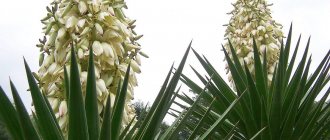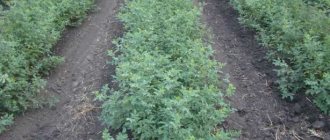Vegetative propagation of blueberries
By vegetative method we mean the separation and rooting of a certain part of the plant.
You can get new bushes using:
- cuttings;
- layering;
- cuttings from an old bush.
Methods for cutting blueberries
You can propagate shrubs by cuttings using two methods:
- In March or December (for southern regions) prepare woody shoots from last year's growth. The diameter of the branches should be at least 0.5 cm, but not more than 1.2 cm. Until rooting, they should be stored in a cool place, placed in a box with peat. In the spring, cuttings no longer than 12 cm should be cut from the twigs and rooted in a greenhouse or bed with further shelter.
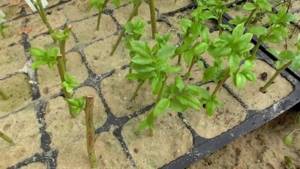
- At the beginning of summer, cut green cuttings (with a heel) from shoots or twigs of the first branching. To reduce the loss of precious moisture, it is better to root them in a greenhouse. Before this, you need to treat the lower sections with a root former.
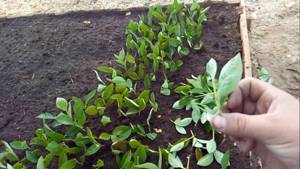
Ordinary garden soil is not suitable for rooting. For lignified cuttings, the soil must be replaced with a mixture of river sand and peat in a ratio of 1:3. Green cuttings take root in peat and pine litter (1:1).
Young bushes can be transplanted to a permanent place in a year, or better yet, in two.
Features of blueberry propagation by layering

Layers should be added in the period from April to early September. To do this, you need to thoroughly loosen the ground under the bush and select strong and healthy shoots from the annual growth. Opposite them, make grooves at least 6 cm deep and place the branches in them, having first shortened them (removing the tops). A wire clamp will help secure the shoot. When vertical sprouts appear, you need to let them rise to 10 cm. Then hill up to half, using peat and sawdust. The procedure must be repeated twice more as the young bush grows.
The advantage of this method is that the plants obtained from cuttings are stronger. Among the disadvantages, it is worth noting the long rooting process. You can separate the cuttings from the mother bush no earlier than after 2 years. This is exactly how long it takes for a new developed root system to form.
Dividing a bush as a way to get several new plants

Some varieties of blueberries are reluctant to produce new growth, so it’s a shame to cut existing shoots into cuttings. But, thanks to the shallow root system, you can dig up an adult bush and divide it into 3-4 parts. At the same time, it is important that each division has its own root, given that the crop does not form new roots well. For the rooting process to be successful, the cuttings should be treated with growth stimulants. It is better to carry out the procedure in the spring, so that before the onset of frost, the separated bushes have time not only to take root, but also to get stronger.
Reproduction by layering
Also, as mentioned above, blueberries can reproduce by layering. This method is used for propagating young bushes that have few shoots for cuttings or for varieties that do not root well when cuttings.
Before this, the trunk circle under the mother plant is loosened. Select strong and healthy shoots. Opposite the selected branches from the base of the bush, a furrow is formed with a depth of 6-8 cm and a length equal to the length of the shoots . Water it with water.
Annual growths of branches are shortened by 1/5 and placed in a furrow. Each segment of a branch with two developed buds is secured to the soil using wire hooks. The furrow is sprinkled with sawdust.
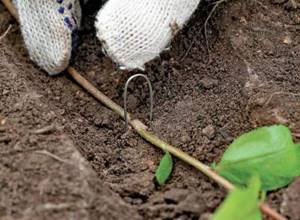
To obtain a full-fledged blueberry seedling, the branch is placed in a furrow and secured with a hook.
After the vertical shoots reach a height of 8-10 cm, they need to be hilled up to half the height . To do this, use a mixture of peat and sawdust (1: 1). This procedure is repeated 2-3 times as the shoots grow. Throughout the summer, the soil is kept moist and loose. The shoots that have grown this year form a full-fledged root system in 2-3 years, after which they are transplanted to a permanent place.
Blueberries are a relatively new crop in Russian gardening, the agricultural technology of which has not been fully mastered by gardeners. The secrets of successful cultivation are based on the correct selection of varieties that are highly adaptable to the harsh conditions for this crop . By planting varieties suitable for the region, you can maintain home blueberry plantations for many years, propagating them by vegetative methods.
How to propagate blueberries by dividing the bush
Blueberry seedlings can be propagated by dividing an adult bush. When dividing a bush, the mother plant is completely dug up. When propagated from one adult shrub, several independent plants are obtained.
Important! The bush is not divided during flowering.
The blueberry root system is superficial, so digging up the bush is not difficult. After removing the bush from the soil, shake off the soil and inspect the roots. Only a completely healthy plant is suitable for replanting. Damaged or dry roots are cut off. The bush is divided manually in such a way that each independent part - division - contains a well-developed root, more than 5 cm long. From an adult bush, 3-4 divisions are usually obtained. After separation, the roots are sprayed with disinfectants, as well as root formation stimulants.
When propagating by dividing a bush, it is important to prepare a place for transplanting new plants in advance. When planting, the roots are straightened so that they are evenly distributed in different directions, otherwise the plant will not take root.
How to cut blueberries and at what time
To propagate garden blueberries from woody cuttings, planting material is harvested in early spring or late winter, in regions with a warmer climate. Cuttings are often combined with general pruning of shrubs. The main rule when collecting lignified cuttings is that the mother plant is in a dormant period. To obtain planting material, annual shoots that have matured well are cut off.
A video about the propagation of garden blueberries by green cuttings shows that planting material is collected in mid-summer. Harvesting time is limited to several weeks during the plant's dormant period. Depending on the growing region and weather conditions of the current season, the collection of green cuttings begins at the end of June. At this time, the first wave of shoot growth is completed, and the next one has not yet begun.
Planting material in the case of green blueberry cuttings is collected from the current year's growth shoots or branching shoots.
How to propagate blueberries from woody cuttings
Chopped woody shoots are tied in bunches. Before planting, they must be stored in a refrigerator or a specially constructed glacier, where the cuttings are left in an alternating layer of snow and sawdust. The temperature during storage should be about +5°C. During this period, the cuttings must be periodically inspected to prevent them from drying out or developing mold.
To propagate blueberries from cuttings at home, prepare a place in the greenhouse in advance. An acidic substrate is poured into a separate box. The planting mixture is prepared from 3 parts of high-moor peat and 1 part of river sand. When planting directly in a greenhouse bed, the soil is removed from it to a depth of 20 cm and replaced with something suitable for growing heather crops.
Depending on the equipment of the greenhouse, cuttings are planted in the spring a month after storing them in the refrigerator. In the video about the propagation of blueberries by cuttings, you can see that the prepared shoots are shortened to 10-15 cm for tall varieties of blueberries and to 7-10 cm for low-growing varieties. The lower cut is made obliquely under the bud, the upper cut is made even, 1.5-2 cm above kidney.
Depending on the expected time spent in the greenhouse, the cuttings are planted on the bed more densely or sparsely according to a 5 by 5 cm or 10 by 10 cm pattern. The cuttings are stuck vertically into the soil mixture and watered. To create the necessary microclimate, arcs are installed above the bed and the planting is covered first with plastic film, then with any non-woven material. In the greenhouse it is necessary to maintain a high air temperature in the range of +26... +28°C and constant humidity. Watering is carried out by sprinkling.
When blueberries are propagated using woody cuttings, rooting takes about 2 months. During this time, plants require constant care. The greenhouse is regularly ventilated, maintaining a constant temperature of the air and soil without sudden changes. The seedlings are watered and treated for diseases.
After the cuttings take root, the cover is removed. Before planting in a permanent place, seedlings are grown for several years. With good care, results from blueberry propagation by cuttings can be obtained in 2 years.
Propagation of blueberries by green cuttings
With the method of green cuttings of garden blueberries, planting material is harvested early in the morning to prevent dehydration of the stem. The side shoot is pinched at the base with the thumb and forefinger and cut off with a sharp downward movement so that the shoot remains with a “heel” - part of the bark from the main branch. A strip of wood that is too long is cut with a disinfected sharp knife or pruning shears. The length of the cutting should be about 10 cm. The lower leaves are torn off, leaving only a few upper ones, which are shortened to half.
To grow green cuttings, mix equal parts of high-moor peat and rotted pine litter. Planting material is placed in a prepared substrate in a greenhouse. The cuttings are placed in a common planting container or cassettes so that the leaves do not touch each other. When caring for plantings, it is important to maintain high air and soil temperatures. When propagating blueberries from green cuttings, their leaves should always remain moist; for this, frequent spraying is carried out or a fogging system is installed.
Advice! For watering blueberry seedlings, do not use chlorinated water.
If blueberries are propagated by green cuttings in a greenhouse, additional shelter is not required in the summer. With proper care, cuttings will take root in 4-6 weeks. In autumn, young plants are covered or transferred to a cool room. In the spring of the next season, the sprouts are transplanted into larger containers for further cultivation.
The survival rate when propagating blueberries from green cuttings is slightly lower than from lignified ones. But harvesting green cuttings is easier and does not require storage space in the winter. Lignified cuttings are collected from formation shoots, which are fewer on the bush than branching shoots, from which planting material for green cuttings is taken.
The cutting method is one of the only possible ways to propagate tall blueberry varieties.
How to root a blueberry cutting
Blueberries take a long time to take root, so before planting the cuttings, the lower cut is dipped in a special powder that stimulates the formation of roots. For heather crops, which include blueberries, root growth accelerators based on indolylbutyric acid are also used. If all growing conditions are met, the average survival rate of sprouts when cutting blueberries is about 50-60%.
Propagation by green cuttings
To use propagation by green cuttings, you will need a pre-prepared area with mother bushes from which you can take harvesting material. The optimal time for the procedure will be mid-summer (late June - early July), and the most suitable shoots are young growth that has grown in the spring or one-year-old shoots left after pruning.
The choice of raw materials should be taken very seriously - the quality of future bushes will depend on this . The selected shoots should be strong and well developed, covered with healthy leaves. It is the leaf cover that will help replenish the stem’s strength before the rhizome appears, feeding it with moisture and minerals.
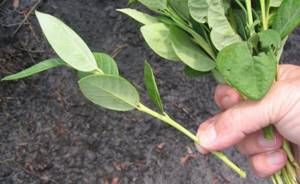
The cutting process occurs as follows:
- The shoots are cut to a height of about 6 cm, after which they are soaked in water or a fungicidal solution, which will act as a disinfectant.
- A special soil is prepared, consisting of acidic peat mixed with microfertilizers, which are intended for the long-term release of useful substances.
- The soil is poured into cassettes, carefully compacted and moistened. Cuttings are planted (to a depth of about 4–5 cm), and the containers with the cuttings themselves are placed in a room (for example, a greenhouse) under certain conditions.
Video: Green blueberry cuttings
Conditions for rooting cuttings:
- The floor covering on which the cassettes will be displayed must consist of drainage. As drainage, a mound of gravel, 10 cm thick, and a layer of sand, 5 cm thick, are most often used. On top, everything needs to be covered with any durable material (agro-fabric can be used);
- The air humidity in the greenhouse must be constantly maintained at 100%. This result can be easily achieved with the help of special foggers, the principle of which is to spray water throughout the room to the size of microdrops. In addition to the humidity level, such equipment also maintains the required temperature;
- The temperature should be at +20. +24°C. In case of persistent summer heat, it is recommended to use additional shading of the greenhouse with nets.
If all recommendations are followed, rooting of cuttings occurs in the fourth week after planting . After this, the seedlings gradually begin to adapt to normal greenhouse conditions, and then the containers with the plants are transferred to an area with open air.
Propagation of garden blueberries by layering
Blueberry propagation by layering is characterized by a long waiting time and low yield of planting material. But this method of propagation does not require special conditions for keeping the seedling; the plant grows strong and hardy.
For propagation by layering, without separating the side shoot of the mother plant, bend it to the soil and cover it with an acidic substrate for growing blueberries or sawdust from coniferous trees. During cultivation, shoots directed upwards grow from the place where the buds are located. They are cared for in the same way as an adult bush, maintaining soil moisture and acidity.
Important! When propagating blueberries by layering, you should not focus on the development of the vegetative mass, because the roots at this time may still be poorly formed.
Rooting during propagation by layering occurs after 2-3 years. After the formation of their own roots, new plants are carefully dug up, cut off from the mother shoot with a sharp garden tool and immediately transplanted for further cultivation in a separate place. If the location is not determined, blueberries can be grown in a container with a suitable substrate.
Garden blueberries: propagation by cuttings, layering, sowing seeds
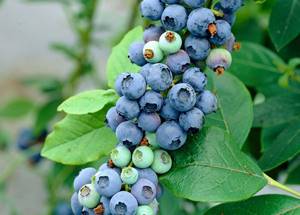
How to propagate blueberries?
Highbush, or garden, blueberries are winning the hearts of more and more gardeners, summer residents and farmers. And of course, many people have a question about how to obtain seedlings in sufficient quantity, while maintaining the characteristics of the BLUEBERRY VARIETIES
.
GARDEN BLUEBERRY propagates
generative and vegetative methods. Each of them has certain advantages and disadvantages, therefore, how to propagate blueberries must be decided, weighing the pros and cons.
Vegetative propagation of blueberries
It is not for nothing that garden blueberries go by other names, such as high blueberry or blueberry tree. Unlike its relatives - common blueberry and swamp blueberry
, it has different morphological features: the plant almost does not form root shoots. Or it produces so little of it that propagating it in this way is problematic.
It should be noted that blueberries are classified as plants that are difficult to propagate vegetatively. This is due to the fact that the plant has poor root-forming abilities. However, with vegetative propagation, the plant retains all varietal characteristics.
► Blueberry diseases
Of the popular vegetative methods of propagating garden blueberries, it should be noted: - cuttings; - propagation by layering; - root shoots.
Propagation of garden blueberries by green cuttings
One of the most successful, fastest and most effective ways to obtain young blueberry seedlings is to root green, non-woody shoots. These shoots are distinguished by their growth rate and more active metabolic processes in tissues, which allows them to take root several times faster than woody shoots. And the percentage of rooted planting material is 2–4 times higher.
When propagating blueberries from green cuttings, one must take into account this feature - the green shoots on different parts of the blueberry are physiologically different from each other. For rooting, it is better not to use flowering branches.
Green cuttings are obtained from the end of June to mid-July - so that on the one hand they have time to accumulate a sufficient amount of nutrients, and on the other hand they have time to take root. The shoots that will be used for rooting should not have spots or chlorosis, the leaves should have a distinct dark green color, and the shoots should be elastic and not brittle.
Green cuttings for propagating garden blueberries are not cut, but broken off with part of the bark, which is then removed. The resulting material is kept in a fungicide solution (10 - 15 minutes), and then parts of the leaf blades are cut off, leaving only 2/3 (the lower leaf can be cut off even further, leaving 1/3). The length of the cuttings is 8 – 12 cm. When planting cuttings, it is necessary to use a rooting agent (according to the instructions).
The cuttings are planted in: • prepared beds located on the ground; • in cassettes with cells that are placed on racks; • into the substrate, which is poured onto racks (usually it is fenced with borders 10–15 cm high); • in transparent plastic boxes with a lid (in this case, you can root blueberries even in an apartment).
►Propagation of chokeberry
►Propagation of cherry
The substrate for rooting can be different: expert opinions differ in this regard. Sometimes cuttings are planted in wet sand, sometimes in clean high-moor peat. But a mixture of sand and peat (50/50), or sand, peat and rotted pine sawdust (in equal parts) is preferable. After planting, the cuttings are covered with film to maintain air humidity, which should remain above 90%. The film should not touch the leaves - the distance from it to the shoots is 20 - 50 cm.
The air temperature during root development should be 20 - 25 degrees. Gradually, as the root system forms - that is, after 4 - 5 weeks, the film needs to be lifted in order to accustom the seedlings to dry air. During this period, you need to spray the leaves less, reducing the relative air humidity to 82 - 85%.
Depending on the conditions and quality of planting material, the cuttings form a root system within 2–3 months. By the end of this period, the film (or glass) must be removed, and the seedlings should feel normal at an air humidity of 40 - 50%. Young plants can be fertilized with ammonium sulfide.
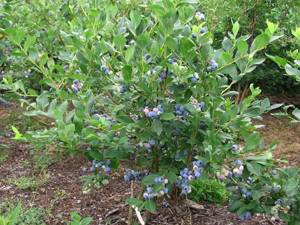
Propagation of garden blueberries by woody cuttings
This method is similar to the previous one: cuttings will need similar conditions and a similar substrate for rooting. Unlike green cuttings, woody shoots take root less easily. Even under optimal conditions and the use of a rooter, the percentage of established seedlings ranges from 20 to 35% (and in the absence of such, the percentage of rooted plants can be only 2 - 3%). On the other hand, some gardeners consider this propagation method to be the most successful.
Shoots for seedlings must be prepared in advance: • cutting of the material is carried out only when the blueberries are at rest (from late November to March); • annual shoots harvested in autumn or winter should be stored in a cold, damp place, with a temperature of 1 - 5 degrees, without allowing them to dry out (in a refrigerator, in a cellar, or in glaciers designed for storing shoots); • the optimal time for cutting shoots is spring, before the beginning of the growing season (approximately March-April, depending on the region and weather conditions); • the length of the cutting for tall varieties should be 11 – 15 cm, and for low ones, slightly less (8 – 10 cm); • the lower part of the cutting is cut at an acute angle to increase the surface of contact with the substrate, and the upper cut, which should be 2 cm above the bud, is usually made horizontal.
►Propagation of currants by cuttings
►Propagation of black currants by layering
Before planting, the cuttings are soaked for 10 - 15 minutes in a fungicide solution, and then the lower part is dipped in a rooting agent (usually it is in powder form). And then they are planted in the prepared substrate (see composition above). In addition to standard rooting agents (such as Kornevin), a special rooting agent has currently been developed for plants from the Heather family (which includes blueberries).
For rooting, it is important that high humidity is created in the room where the cuttings are located - the optimal figure is 90 - 95%. To maintain this indicator, water sprays are used to create fog. An easier way is to cover the seedlings with a transparent film with holes made in it for air circulation. The height from the film to the surface of the substrate is 40 - 50 cm. In this case, sprayed water reaches not only the cuttings, but also the film, and the desired microclimate is created. The presence of a film over the seedlings allows you to avoid temperature fluctuations and gradually adapt them to drier air.
The advantage of the resulting blueberry seedlings, obtained from lignified cuttings, is that after rooting and adaptation, they are already quite ready for planting in the ground in a permanent place.
Propagation of blueberries by layering
As already noted, it is difficult to force tall blueberries to take root, therefore, propagation by layering may take a couple of years. In order not to damage the plant, the soil around it is loosened, and next to the shoots intended for rooting, a furrow 7–8 cm deep is made, which I spill with water. Then, the shoot is placed in the furrow, having first torn off the leaves on its lower part (that is, where the branch will be covered with earth).
The shoot must be secured with wooden or metal hooks, and then sprinkled with wet pine sawdust and peat (or a mixture of sand, peat and pine needles). The sprinkled shoot must be kept moist, preventing the substrate from drying out.
Blueberry propagation in-vitro
This method of vegetative propagation allows you to obtain hundreds, thousands and even hundreds of thousands of blueberry seedlings, while being devoid of any viruses and infections. Its only drawback is that this method requires special laboratory conditions and knowledge of technology.
This method is used by some domestic research and production enterprises and nurseries. In the USA, Canada and some countries of Western Europe, where large-scale cultivation of this berry has been established, in-vitro propagation of blueberries makes it possible to obtain seedlings on an industrial scale for cultivation on blueberry plantations.
Generative propagation of blueberries
Seed, or generative, propagation of blueberries is most often used by breeders to obtain new varieties and forms of this plant. The main disadvantage of the method is that blueberries may lose their varietal characteristics: the resulting seedlings will be very different from the mother plant, and not necessarily for the better.
►Propagation of garden strawberries
Another drawback is the length of cultivation. More than ten years can pass from the moment of sowing to active fruiting. For propagation, overripe berries are selected, from which seeds are obtained. The seeds are washed, dried and sown in moist peat (or peat with sand). Sowing can be done immediately, or you can leave the seeds until spring. Grow seeds in greenhouses or covered containers to maintain moisture. When growing seeds in plastic containers, you need to make holes in them for ventilation.
► RETURN TO SECTION
“Website about plants” www.pro-rasteniya.ru
| < Previous | Next > |
Methods of propagating garden blueberries and choosing timing
Methods for propagating blueberries are divided into two main groups. This is sexual, which is carried out by seeds and vegetative - by parts of the plant. Propagation by seeds at home is a painstaking job, which includes culling unsuitable ones and selecting promising seedlings. This may take several years. Therefore, this method is practiced only for breeding purposes to develop new varieties.

Blueberry seeds
Vegetative (asexual) methods of propagation make it possible to preserve varietal characteristics of blueberries. Each option has its advantages and disadvantages, so gardeners choose the most suitable method for their individual case.
Propagation of garden blueberries by cuttings occurs due to the regeneration process, during which new adventitious roots are formed from stem tissues. Shoot growth occurs from existing buds.
When choosing a green cuttings method, pay attention to the age of blueberry shoots. As the shoot becomes lignified, metabolic processes, water supply and water-holding capacity of tissues - important conditions for the formation of new roots - decrease. Thus, planting material from green shoots develops faster and gives a higher percentage of plant survival after rooting.
Planting material from certain parts of blueberries have different degrees of rooting. Cuttings from coppice shoots have the highest root-forming ability . The roots of coppice shoots are formed from adventitious buds, which are characterized by increased metabolism, which accelerates the formation of new cells. This increases root formation by 3-4 times than that of cuttings taken from the fruiting zone. Planting material is harvested at the end of June, at the beginning of July.
Blueberries can also be propagated from woody cuttings . Planting material can be stored for a certain amount of time under optimal conditions. Therefore, lignified cuttings are often prepared for transportation over long distances or for planting the next season.
There is no specific time for cutting cuttings that guarantees the best results. The opinions of many agronomists on this matter are divided. The main condition for harvesting high-quality planting material is a healthy shoot and dormant buds. In regions with harsh winters, it is recommended to take cuttings at the beginning of winter, but for other regions it is permissible from December to the first ten days of March.

Blueberry seedlings can also be obtained by layering, but this is a long and unproductive process.
Blueberry seedlings can be obtained using layering . The essence of this method is rooting the stem without separating it from the mother plant. This is one of the natural methods of plant propagation, the technology of which is available to any gardener. The disadvantage of this type of reproduction is the duration of the process. Rooting of cuttings can last 2-3 years . The ideal time for this method is the growing season of blueberries, so it is carried out from mid-April to September.
Blueberries are one of the most difficult berry crops to propagate. This is due to the biological characteristics of plants - low root-forming ability. The best results are achieved by propagation methods by cuttings.
Basic methods of reproduction
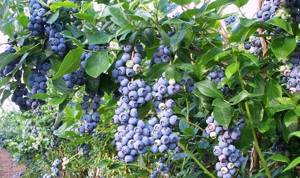
There are three ways to propagate garden blueberries:
- seeds;
- cuttings;
- layering.
Each of them has its pros and cons. For example, obtaining blueberry seedlings from seeds is a long, labor-intensive and very specific process, so it is used only by breeders to obtain new varieties of blueberries.
Reproduction by layering is also a rather lengthy process; in addition, it produces little quality planting material. But there are incomparably fewer problems with rooting new plants than with rooting blueberry cuttings.
Reproduction by cuttings
Methods for harvesting and rooting green and lignified cuttings have differences and similarities . Regardless of the planting material, the gardener must carry out the procedure with minimal disruption to the biological characteristics of the plant.
Preparation of green cuttings
With this method of reproduction, compliance with the optimal timing is of particular importance. This is the period from June 20 to July 10 .
Cuttings from insufficiently matured shoots often suffer from drying out and are affected by diseases and fungal spores. The leaves of such cuttings are not sufficiently developed and cannot supply the stem with nutrients in sufficient quantities. When harvesting cuttings later, nutrients enter the growth points, which leads to their loss and affects the formation of roots.
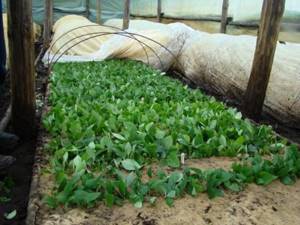
Green blueberry cuttings
Shoots ready for cuttings have springy, unbreakable stems and dark green leaves. For cutting cuttings, choose strong shoots of the first and higher orders of branching with a height of 6-12 cm . They are broken off by hand with part of the wood and bark of last year's growth (heel).
Preparation of the cutting:
- processing the lower part of the cutting (removing exfoliated bark);
- removal of 2-3 lower leaves (1/3 of the length);
- trimming the remaining leaves by 1/3;
- treatment of cuttings with growth stimulants
The cuttings are planted on a prepared ridge in greenhouse conditions.
Preparation of lignified cuttings
To prepare cuttings, select last year's formation or replacement shoots that are fully mature and undamaged by frost with a diameter of 0.5-1.2 cm. Cuttings with a larger diameter take root poorly, and smaller ones are produced by weak plants. Shoots with a large number of flower buds are not suitable for propagation; removing them also does not give positive results.
Branches cut in winter are stored in boxes filled with peat or sawdust and holes for aeration. The boxes are placed in a dark, well-ventilated room at an air temperature of 0°C - +5°C . At the end of March or April, cuttings are cut. The lower parts of the branches have the best root-forming ability.

The easiest way to propagate blueberries is from woody cuttings.
The cuttings are cut with sharp pruning shears, avoiding pushing and damaging the bark.
Cutting steps:
- cutting length 10-12 cm;
- the lower cut is made under the bud with a slight slope;
- the upper cut is 0.5 cm-1 cm above the bud;
- the cuttings are treated with growth stimulants.
If there is little planting material, it is permissible to cut cuttings of a smaller size, but with the condition of at least 3 vegetative buds.
Rooting cuttings, planting and care
Green and lignified blueberry cuttings are rooted in ridges or boxes, creating greenhouse conditions for them. The rooting site can be of any convenient size, but with a height of at least 15-20 cm . The ridge is placed on a layer of drained soil, expanded clay or coarse sand. You can choose a greenhouse as a room or install removable frames with glass (polyethylene) over the ridge.
The most optimal substrate for the development of cuttings is a mixture of high-moor peat with river sand (1: 1). One day before planting the cuttings, the substrate is sifted and spilled with warm water. The prepared ridge is covered with plastic film to completely saturate the peat with water.

Planting blueberry cuttings in containers
Lignified cuttings are planted according to a 5x3 pattern, and green cuttings according to a 5x5 pattern, leaving 1-2 buds on the surface of the substrate . The entire rooting period maintains a temperature of +20°C-+25°C and light substrate humidity.
The roots of the cuttings begin to form after 4 weeks. During this period, the plants begin to gradually become accustomed to drier air, periodically removing the film and glass. 2-3 months after planting, glass or film covers are completely removed and fed with ammonium sulfate (10 g/m2) .
Young plants are left to overwinter at the rooting site. To do this, they are mulched with a 5 cm layer of peat, sawdust or fallen leaves. In the spring, after the soil has warmed up, they are transplanted to a permanent place.
Even with proper preparation of cuttings and provision of the necessary conditions, blueberry rooting rates remain at a very low level of 25-35%. These indicators can be increased by 2-3 times with the help of special care - treating the cuttings for 12-24 hours with a growth regulator - an aqueous solution of indolyl-butyric acid (50g/1 l).
Propagation by lignified cuttings
When using the propagation method using lignified cuttings, mature one-year shoots will be required. In autumn, the harvesting material is cut from the bush and stored until spring in conditions of low temperatures (+3...+6°C). A cellar or refrigerator is well suited for these purposes. Rooting can begin in March if planting is carried out in a heated greenhouse with a temperature of +20°C, or at the end of April - beginning of May in a greenhouse without heating.
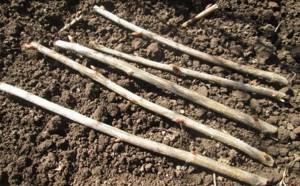
The process itself consists of several stages:
- The prepared shoots are cut into pieces, the length of which is 12–15 cm for tall varieties and 8–10 cm for short ones. The lower cut is made oblique and is located immediately under the kidney. The top is cut at a right angle at a distance of about 2 cm above the bud.
- To root cuttings, use pre-prepared cassettes filled with peat or a mixture of equal parts of peat, sawdust, sand and bark.
- Cuttings that have been allowed to pre-lignify are planted according to the standard scheme: at a distance of 5x5, 5x7 or 10x10 cm. Wire is pulled over the beds and covered with plastic film on top.
Video: Blueberry cuttings using woody cuttings

Rooting of lignified cuttings takes up to 7–8 weeks, during which the shoots need frequent watering and regular ventilation . You should also pay special attention to the temperature regime - overheating or hypothermia of the planting material should not be allowed.
Important! Since blueberries are difficult to root crops, it is recommended to treat all cuttings with a biogrowth stimulator before planting.
Propagation of blueberries by cuttings
The best time for cutting cuttings is the last ten days of June to the beginning of July inclusive, when annual growths have not yet become lignified. The event can be combined with thinning the blueberry bush. Cut off young branches that thicken the crown.
Annual semi-lignified twigs are used for cuttings
Remove the green tops of each shoot. Divide the rest into cuttings with 2-3 internodes. Cut off the bottom leaves entirely, leave only the top two and shorten them by half. The lower cut of the cutting should be sharp, with a bevel in the opposite direction from the growth of the lower leaf.
A - for cuttings, take the middle part of a side branch. B - the cut is made at an acute angle and not parallel to the growth of the bottom sheet. B - the cuttings are treated with a rooting agent. D - blueberry cuttings are planted in a loose and acidic substrate
The soil for blueberries should have an acidic pH of 4 to 5. Humus, compost, manure and even ordinary garden soil are contraindicated for this crop, since they have a slightly acidic and neutral reaction. The substrate can be composed of peat, river sand, pine litter and rotted sawdust in any proportions.
Before planting, keep each cutting in a root formation stimulator (Kornevin, Heterouxin, Epin, Ecogel and others). Plant in boxes in rows (5x10 cm) or in separate pots, deepening the cuttings halfway. Rooting should take place at high humidity and elevated temperature. Set up a mini-greenhouse or greenhouse. When young leaves begin to grow on the cuttings, the greenhouse can be ventilated, and after a week it can be removed completely. In the fall, a month before frost, transplant the strengthened seedlings to a permanent place.
Video: taking cuttings and planting
How to root a cutting
When rooting cuttings using any of the chosen methods, you should follow several recommendations:
- beds, cassettes or boxes prepared for rooting cuttings can be of any size, but their height must be at least 17-20 cm;
- the prepared soil should be placed on a drainage layer, which can be expanded clay or coarse sand;
- a greenhouse can serve as a place for beds, or, provided there is open ground, you can use removable frames covered with glass or polyethylene;
- the optimal substrate for rooting cuttings is high-moor peat and river sand in a 1:1 ratio;
- 1 day before the expected date of planting the cuttings, the substrate must be sifted and watered with warm water, then left under polyethylene for a day (this will make it possible to moisten it evenly);
- cuttings are planted at a depth that requires 1–2 buds to be above the soil surface;
- a few months after rooting, the cuttings should be fed with ammonium sulfate at the rate of 10 g per 1 m²;
- The cuttings should spend the first wintering at the rooting site. To do this, mulch with a layer of 5 cm using peat, sawdust or fallen leaves;
- The cuttings are planted in a permanent place in the spring, after the soil has completely warmed up.
Read also: There is not enough brine in the cabbage, what to do

Reproduction by horizontal layering
In spring and early summer, choose strong and flexible branches that can be laid on the ground. If it is only possible to bend them in an arc, then the seedling will turn out to be one with roots at the point of contact with the ground, and if you manage to dig in most of the branches, then several bushes will grow. The easiest and most reliable way is to propagate blueberries by horizontal layering:
- Measure the branch where you want to bury it and make a shallow (5–7 cm) groove in the ground.
- Scratch the side on which the branch will come into contact with the ground with at least a fingernail and moisten it with a preparation that enhances root formation.
- Attach the branch to the ground with wire pins and cover with soil. If the branch does not fit, is bent in an arc and comes into contact with the ground in only one place, you can dig it in and press it down with a brick or stone. In any case, the top of the rooted branch should be outside, above the ground.
- Keep the soil moist all summer.
- Next spring you can dig up our branch, cut it from the mother bush and divide it into seedlings. But from the experience of gardeners, it is known that blueberry branches have to wait 2–3 years for rooting.
Video: rooting by digging and air layering
Blueberries from seeds
Propagation by seeds is a very interesting, but also labor-intensive method:
- You can buy seeds in a store in your city, order them online, or collect them yourself from berries, your own or purchased at the market.
- The soil is acidic peat, which can be mixed with coarse sand and rotted sawdust. Peat tablets are perfect.
- Sowing dates are easy to calculate. Stratification for blueberries lasts up to 90 days; it is advisable to obtain seedlings in March, when the sun begins to illuminate our windowsills well. Therefore, you need to start working with blueberry seeds in early December.
- Sowing is carried out superficially without deepening. Blueberry seeds are very small; the seedlings do not have enough strength to break through even loose soil. Moisten the substrate before sowing; if you water it after, the water will draw the seeds deeper. You can sow each seed in a seedling box in rows or individually in a peat tablet or cup.
- Cover the crops with glass or wrap them in a plastic bag and place them on the bottom shelf of the refrigerator for 3 months. Once a week you need to take it out, air it and, if necessary, moisten it.
- In March, transfer the crops to a bright and warm windowsill. After 1–3 weeks, shoots should appear. Grow them like regular seedlings. But do not forget to use special acidic soil from peat for picking without adding soil, humus and other components familiar to us.
Blueberry seeds and loose substrate
Video: rules for stratification in the refrigerator and in the garden under the snow
Reproduction methods and timing
Blueberries can be successfully propagated using seeds and parts of the bush. The first method takes a lot of time, requires considerable effort and does not guarantee the preservation of economic and genetic properties of seedlings. To preserve the qualities inherent in varietal blueberries, a vegetative propagation method is used by cuttings, layering, and root shoots.
A modern achievement of biologists is microcloning of biological tissue taken from a plant.
The choice of propagation method depends on the region, age of the bush, variety, and the choice of timing depends on the type of planting material. In autumn and spring, blueberries are bred using ready-made seedlings and root shoots. Shoot segments and stratified seeds are planted only in spring.
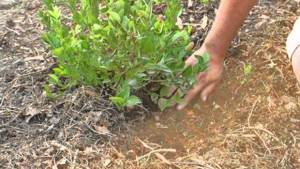
Features of cuttings
A popular way to propagate blueberries is by rooting green, woody or root cuttings, starting with the selection of quality material.
Lignified
From December to March, shoots are harvested from young annual plants and stored in bunches at a temperature of 0–4°C. If the blueberries are low-trunked, cut the branches into 10 cm long sections; for high-trunked varieties, 15 cm long. The lower part ends with an oblique cut under the bud.
The top is cut horizontally, leaving 2 cm to the top bud, preventing drying out of the growth zone. Before planting, the bottom of the cutting is powdered with Kornevin or dipped in a solution made from a liter of water and 1 g of a substance that stimulates root formation for 2–7 days.
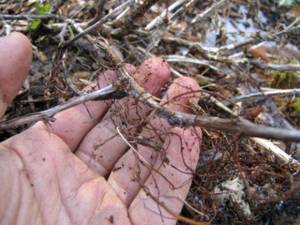
At the end of March or April, the cuttings are planted in a greenhouse, having previously prepared a box filled with peat substrate. A part of the plant with two buds is left above the ground. You can dig it right into the garden bed, covering it with film or spunbond stretched over arcs. Planting pattern: 5 to 10 cm between plants and rows. The rooting period is from two months.
Green cuttings
Blueberry cuttings are more effective in the summer. A larger amount of planting material takes root, the rooting period is reduced (1.5 months). In the summer, from the last days of June to the end of July, new growth or branching shoots are selected. Areas that form inflorescences are unsuitable.
When harvesting, green shoots are separated with a sharp jerk downward so that a section of last year's stem bark remains on them. The lower part is freed from foliage and treated with a root formation stimulator. The remaining leaves are thinned out so that after planting the semi-lignified cuttings in the greenhouse, they do not touch.

Favorable conditions for rooting are regular soil moisture, indicated by the condition of the leaves, and a temperature in the range of 18–22 °C.
We grow blueberry seedlings
Blueberries take a long time to take root: at least 8 weeks. All this time, regularly moisten the soil in the bed with cuttings and periodically ventilate the greenhouse. Before the leaves appear, water the plantings 1-2 times a week, and when the leaves bloom, several times a day (until the roots appear, the leaves on the blueberry cuttings should be constantly moist). The soil should not be overheated or overcooled during the rooting period (the optimal substrate temperature is 18-21°C).
If you notice signs of disease on the cuttings, treat them with Azophos, Cuprozan, Topsin-M or Fundazol. To protect against pests, you can use Ambush, Rogor-S or any other suitable insecticide.
With the onset of the second wave of shoot growth, begin feeding the blueberries with Mortar (1 tbsp per 10 l of water), Kemira (1 tbsp per 10 l of water) or any other universal liquid chlorine-free fertilizer. In total, carry out 5 such feedings with an interval of 7 days, consuming at least 1.5 liters of solution per 1 sq.m. After each feeding, be sure to hose down the cuttings with clean water to wash the fertilizer off the leaves.
Read also: Gazebo 2 storeys
When the cuttings take root (usually this happens after the second wave of shoot growth), begin to accustom them to natural conditions: water less often and ventilate more often. At the end of August - beginning of September, remove the film and spunbond altogether, and from the second half of September, reduce watering of the seedlings so that when cold weather sets in, the soil is not too wet.
At the end of summer or next spring, transplant blueberries into containers with a volume of at least 1.5, and preferably 2, liters. Seedlings that will overwinter in containers should be covered with a 10-centimeter layer of damp (but not wet!) sawdust or peat before the onset of cold weather. And cover the plants remaining in the garden bed with spruce branches, having first removed all fallen leaves.
After 1-2 years, the grown blueberry seedlings will be ready for planting in a permanent place. Read about how to do this correctly in our article.
With proper care, you can harvest up to 8 kg of berries from one blueberry bush.
Blueberries are not the easiest plant to grow. In order to propagate it from cuttings, patience and skill are required. But your efforts will be rewarded with a good harvest of delicate sweet and sour berries, which are also considered one of the healthiest in the world.
Garden blueberries, although not a fairly common berry crop, are, however, valued among many experienced gardeners for their taste characteristics and beneficial properties. It is known that planting new or renewing old bushes requires young seedlings of the crop, which can always be purchased at specialized markets.
But, to save money and guarantee a healthy plant with the preservation of all varietal characteristics, many gardeners resort to independent propagation of blueberries. This process is quite complex and has several main methods - we will consider the most common of them below.





